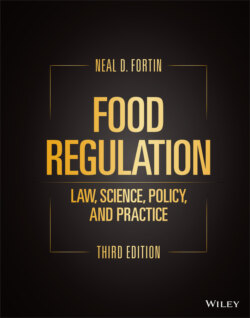Читать книгу Food Regulation - Neal D. Fortin - Страница 121
Beverages Containing Juice
ОглавлениеBeverages that purport to contain juice must declare the total percentage of juice on the information panel. In addition, FDA regulations set detailed criteria for naming juice beverages. For example, when the label of a multi‐juice beverage states one or more—but not all—of the juices present, and the predominantly named juice is present in minor amounts, the product’s name must (1) state that the beverage is flavored with that juice, or (2) declare the amount of the juice in a 5 percent range—for example, “raspberry‐flavored juice blend” or “juice blend, 2–7 percent raspberry juice.”33
* * * * *
When Is Peach Juice Apple Juice?
Marian Segal, FDA Consumer, Special Issue, Focus On Food Labeling (May 1993).
When it comes to juice labeling, there are those who would disagree with Shakespeare’s sentiment that “a rose by any other name would smell as sweet.” If the label implies that it’s peach juice, they contend, it shouldn’t consist mostly of apple and white grape juice—especially without saying so on the label….
The rule‐making process on declaration of percentages of juice goes back many years, beginning with debates over standards of identity for diluted juice beverages. In 1974, FDA proposed a regulation to establish common or usual names for juice drinks instead of developing standards.
After many objections, tie‐ups, and reworkings—including a final regulation in 1980 that never had an effective date, and two more proposals in 1984 and 1987—the Nutrition Labeling and Education Act came along in 1990 requiring that “a food that purports to be a beverage containing juice must declare the percent of total juice on the information panel.”
But this alone would not solve the problem of misleading labels. Many manufacturers today use bland juices, like apple or white grape, as diluents instead of water, and call the product a 100 percent juice blend.
“Some of these labels are just not informative,” Campbell says.34 “The label says 100 percent juice blend or 100 percent natural juices, but only the expensive juices—the raspberry or strawberry, which are in smaller amounts—appear prominently on the principal display panel. You have to look for the grape and the apple in the fine print.”
To correct this, the FDA elaborated on the 1990 law, proposing that manufacturers be required to declare not only the total percent of juice, but the percent of each juice named or pictured on the label of a multi‐juice beverage.
In responding to the proposal, however, manufacturers protested that this requirement would be impractical and difficult to comply with. They explained that juice, as an agricultural product, varies in strength, flavor, solids, and color. If they were required to state a percentage, they wouldn’t have the flexibility necessary to adjust the amount of juice—using a little bit less or a little bit more or a little sweetening—to get the desired flavor. Nor would they be able to vary their formulas as driven by fluctuations in cost or availability of individual juices.
In addition, they said the amount of juice they use in their formulations is proprietary information, and requiring them to reveal this information in 1 percent increments would force them to divulge their secret formulas.
The final rule allowing a statement that the beverage is flavored, or declaring the amount of juice named in a 5 percent range, addresses manufacturers’ concerns, while providing more accurate information for consumers.
* * * * *
